Horses become nervous and anxious for a number of reasons—Something rustling in the brush, a loud noise, an unfamiliar location—or for no particular reason that we can understand. Certain breeds seem to be higher strung than others, but that’s not necessarily a rule to live by because we all know the Thoroughbred that is bomb-proof and the cow bred Quarter Horse that is a bomb waiting to explode. Along with natural tendencies; Injuries, accidents, mishandling and some commonly used training methods can create an anxious, even fearful horse.
Why Horses Are Anxious
The popular belief that horses are hyper-vigilant, nervous, or anxious because they are prey animals is not necessarily the reason for ongoing anxiety. There is quite a bit of research today that dispels the prey/predator myth, especially as it relates to the horse/human relationship. The most recent research results on this topic are to be published soon in a book by Dawn Adams, Ph.D. and Jo Belasco, Esq.
Understanding the biological reason that some horses, just as some people, are more prone to being high-strung and nervous can help us calm our anxious horse. What we now know as a result of mind-body science is that “high-strung and nervous” are all part of the flight/fight response that culminates in Post Traumatic Stress (PTS). For a simple explanation, we can look at nervousness and anxiety as signals from the body to be on alert and prepare to run; fear is the trigger to run and escape, PTS is the result of not being able to escape.
There are solid, scientific, and biological reasons for nervousness, anxiety, and fear. The difference between being “simply nervous” and terrified is the degree of the flight/fight response. This response is governed by neurotransmitters that are received by certain cells located throughout the body including the brain. We used to credit this to adrenalin. It is now known that there are a number of neurotransmitters involved in triggering the flight/fight response, there are physical responses and other neurotransmitters involved in calming the body after the danger is gone.
Just as with humans, as long a horse is subjected to a threat and can’t escape, the neurotransmitters associated with flight/fight keep firing—telling the horse (or the person) to run, escape, and survive. When escape is not possible or does not seem possible, the nervous system can become over charged because the cells that receive these neurotransmitters are no able to discharge the overload. This can lead to higher than normal levels of nervousness, anxiety, and even PTS. Yes, horses can have PTS.
The ability for some to discharge the neurotransmitters is why some horses can be calmed by lunging or running around the arena, but for others the same activities have little or no effect no matter how tired they may become.
Are you prepared to leave your animals with a pet sitter? Help communicate all the vital care instructions with a Horse and Pet Care Communication Checklist.
Offering Your Horse a Helping Hand
There are some easy hands-on techniques you can use to help calm your anxious horse. These techniques release restrictions in the fascia (a web of connective tissue), help balance the craniosacral system, and balance the acupressure meridians associated with stress.
If you are curious about the fascia and its role in pain, structural imbalance, and trauma, there’s a link to additional reading at the end of this article.
These techniques are not necessarily presented in any order of preference. Everyone is different and every horse is different. I suggest you try all of these techniques over time and you will soon discover which ones work best for you and your horse.
These techniques are not intended as a substitute for veterinary care. If your horse has been injured or is ill, call your veterinarian.
Apply any or as many of these techniques as you like, daily if possible for a week or two and before and after working or riding your horse. As relaxation becomes a pattern you’ll begin to notice changes in your horse’s behavior. Make your favorites part of your regular routine. After grooming before being put away for the day is a nice time.
Preparing Yourself to Calm Your Anxious Horse
It’s important that you feel well grounded and find a comfortable stance because you will be standing for awhile. Dress appropriately for the weather so you are neither too warm nor too chilled. If it’s cold, gloves are okay, but may dull your sense of feel.
Calm yourself, quiet your mind and begin when you feel ready.
If you like, you can do the following energetic exercise before starting work.
- Stand with your feet placed comfortably apart and knees relaxed.
- Hold your palms together in front of you close enough that you can feel some heat (energy) between them.
- Slowly separate your palms as far as you can without losing that sense of heat or energy between your them. It may even begin to feel like a bubble or ball.
- Slowly bring your palms back towards each other, getting as close together without touching.
- Repeat this three to five times until you have a sense of the heat or energy ball getting stronger. If you don’t feel it getting stronger, don’t worry. It is.
How Do We Know the Horse Has Relaxed?
Your horse tells you he is relaxing by:
- Relaxing his ears, softening or closing his eyes, blinking rapidly, lowering his head and neck
- His lower lip droops and he may drool
- Sighing and a change in breathing, sometimes becoming more rapid and deeper
- An increase in gut sounds and passing gas
- Feet shifting, sometimes squaring up
- Licking, chewing, yawning
- Stallions and geldings have an obvious way to show they are relaxed!
Any one of these is a sign that the horse relaxing. Three or more over a period of up to 20 minutes demonstrate the horse has calmed considerably. But you know our horse best so use your own judgment.
Logan Basic – Modified
This technique releases the Sacrotuberal Ligaments, which connect the Sacrum to the Ischial Tuberosity; it is a standard technique for releasing the pelvis, and is also very helpful for settling an anxious horse.
Equine chiropractors use this method but in a different manner than presented here. Ligaments are primarily fascia so the longer you can maintain this contact the more your horse relaxes.

- From one side, reach under the horse’s tail and find the 12 o’clock position just above the anus. You will be working from the 11 o’clock and 1 o’clock positions.
- If you are on the right side of the horse, move your hand to the 11:00 o’clock position. From the left side, work at the 1 o’clock position.
- Applying your first two fingers, gently pull towards you as you are palpating, feeling for a thick ligament that feels something like one of those large rubber band used on produce.
- Hold the pressure for at least two minutes, following the softening to the next level of tightness (barrier). Spend at least five minutes working through the barriers.
- Repeat on the other side.
Important tip: Remember to wash your hands after this technique!
Acupressure Points
Keep in mind that there are additional points to work that can also calm a horse. These here are the ones I have found to be most effective. The fascia plays an important role in acupressure because the meridians are in the fascia. Restrictions in the fascia can cause acupressure and it’s derivative therapy, acupuncture to be less effective. Acupressure is much older than acupuncture.
Gall Bladder 21 and Bladder 21, 22, 23
Simultaneously holding these points have a calming effect. You can hold them by cupping your palm over them, or by gently pressing the fingertips of one hand into GB 21, and cupping the Bladder points with your entire other hand. Sometimes, working only one side is enough to calm the horse, but make it a routine practice to work both sides.

The Gall Bladder Meridian (Official of Decision and Judgment) impacts aspects of emotion and energy. Horses do not have a gall bladder but do have a bile system that regulates the flow of bile.
- Regulates the flow of energy (Chi)
- Governs the decision-making process
- Rules parts of horse’s body including ligaments, tendons, joints, and muscle
- GB 21 in particular relaxes the muscles. WARNING! Do not work this point on mares in foal or thought to be in foal. It can induce labor and cause a miscarriage.
The Bladder Meridian (The Great Mediator) has the unique facility of helping to balance the entire meridian system. On an emotional level, the Bladder meridian addresses fear, depression, worry and agitation.
- BL 21—Association point for the Stomach Meridian and relates to gastrointestinal disorders. Working this point helps regulate stomach Chi.
- BL 22—Association point for the Triple Heater Meridian. Triple Heater Meridian (Official of Balance and Harmony) is a function rather than an organ, representing a group of energies and involves many organs. The Triple Heater transforms and transports Chi to all parts of the body.
- BL 23—Association point for the Kidney Meridian (Residence of Resolution). Emotionally the Kidney meridian deals with survival and fear. A horse who exhibits unusual fear reactions or a basic lack of safety benefits from work along the Kidney meridian.
Bladder Meridian / Governing Vessel Meridian
There is a collection of at least three non-specific ‘points’ along the Bladder Meridian between the withers and lumbar region that can be worked. I say ‘non-specific’ because as you palpate along this meridian, you can feel small vortexes. Holding these vortexes calms the horse.
The vortexes may be related to regionally associated Bladder points that have to do with calming, balancing from overexertion, and emotional tension. They may also be generally associated with the Governing Vessel Meridian, which is closely related to the central nervous system.
I was made aware of these vortexes during Biodynamic Craniosacral studies. They relate to nerve ganglia along the spinal column. Locating and holding the vortexes have a calming effect on the horses, humans and dogs I have worked with.
Sensing the tides
Stand beside the horse, facing the horse’s body. Place on hand on the scapula and the other hand over the hip joint.
As you stand next to the horse, with your hands placed as described, you may become aware of a tidal motion, or sensations of “invisible movement.” These are craniosacral rhythms and the universal tides as described by Dr. Sutherland, the developer of craniosacral therapy.
You may also experience a very deep stillness that seems like everything around is slowing down. This is a still point during which the body is reorganizing at a very deep level.
Hold this technique for at least 20 minutes. Working one side is all that is necessary, but for added benefit you can work both sides.

Transverse Plane Holds
You may also experience the same senses of movement or stillness as described in the previous technique. Hold the technique you choose for at least 20 minutes.




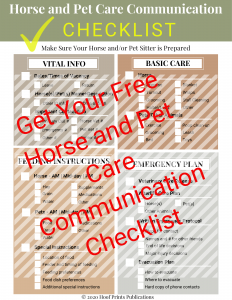
Are you prepared to leave your animals in the care of a pet sitter? The Horse and Pet Care Communication Checklist enables you to gather all the vital information you need to communicate all the elements of all your animals’ care to your pet sitter. What if you suddenly had to leave town? Would you be ready for someone to quickly step in and take care of your animals? What if something happened to your horse or pet while you were away? Would your pet sitter know your wishes? This checklist will help you prepare your pet sitter to care for your animals the way you do. Get your Horse and Pet Care Free Checklist here >.

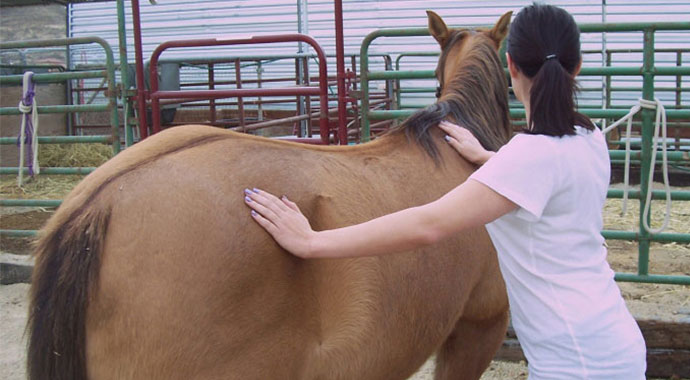
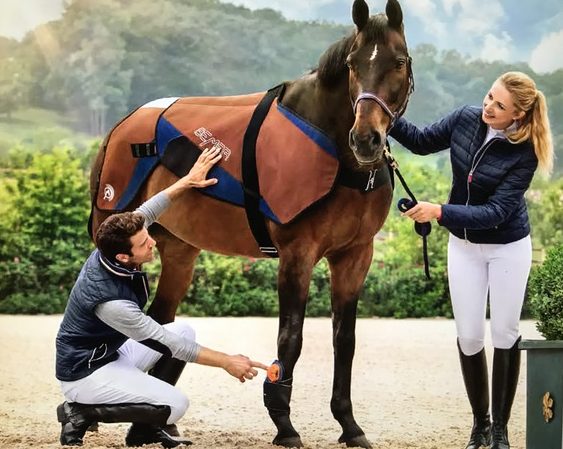
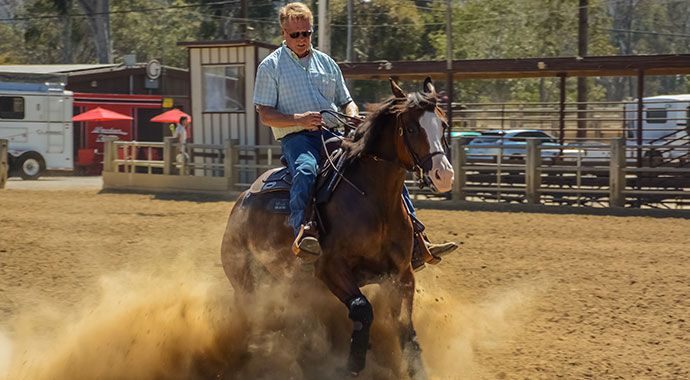
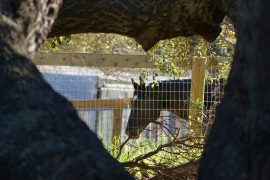
Really interesting and informative article!
Had some amazing healing work done with Jackie for the first time! Jackie worked on a horse and myself yesterday and what a wonderful gift she truly has!
Lori Harmon
Equine Alliance Youth Foundation